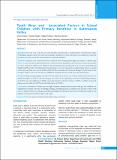Please use this identifier to cite or link to this item:
https://hdl.handle.net/20.500.14356/1469| Title: | Tooth Wear and Associated Factors in School Children with Primary Dentition in Kathmandu Valley |
| Authors: | Dahal, Sirjana Poudel, Prakash Pradhan, Megha Mainali, Bhawana |
| Citation: | DahalS., PoudelP., PradhanM., & MainaliB. (2021). Tooth Wear and Associated Factors in School Children with Primary Dentition in Kathmandu Valley. Journal of Nepal Health Research Council, 18(4), 637-643. https://doi.org/10.33314/jnhrc.v18i4.2518 |
| Issue Date: | 2020 |
| Publisher: | Nepal Health Research Council |
| Article Type: | Original Article |
| Keywords: | Factors Primary dentition Kathmandu valley Tooth wear |
| Series/Report no.: | Oct-Dec, 2020;2518 |
| Abstract: | Abstract Background: Tooth wear is the loss of tooth structure from physical or chemical attack of nonbacterial origin. Predominant causative factor for tooth wear in primary dentition is erosion. This study was conducted to assess the prevalence of tooth wear and its associated factors in primary dentition. Methods: Analytical cross-sectional study was conducted after obtaining ethical approval among 425 children aged two to 12 years, enrolled in different preschools/schools located in Kathmandu valley. Informed consent from parents as well as assent from children were obtained. Oral examination for assessing tooth wear was done using Smith and Knight Tooth Wear Index. Self-administered questionnaires were sent to parents for considering the factors associated with tooth wear. Data were entered in Microsoft Excel Sheet and analysed in Statistical Package of Social Sciences. The chi-square/fisher’s exact test was done to establish the association between tooth wear and various factors. Results: Among total participants, 295 (69.4%) had tooth wear in at least one or more teeth. Tooth wear was seen significantly higher in children with increasing age (p<0.001). It was significantly associated with brushing technique (p=0.022), type of toothbrush (p=0.005), increasing duration of bottle feeding (p=0.003), in children frequently taking sour food stuffs (p=0.019) and soft drinks/juices (p<0.001). Conclusions: Prevalence of tooth wear was high in primary dentition that increased with age. The condition was significantly associated with type of brushing technique, brushing frequency, materials used and type of diet. Tooth wear is a major problem in young age group having multifactorial etiology. It may lead to dental hypersensitivity and pulpal involvement if not followed up in early stages. Keywords: Factors; primary dentition; Kathmandu valley; tooth wear |
| Description: | Original Article |
| URI: | http://103.69.126.140:8080/handle/20.500.14356/1469 |
| ISSN: | Print ISSN: 1727-5482; Online ISSN: 1999-6217 |
| Appears in Collections: | Vol. 18 No. 4 (2020): Vol. 18 No. 4 Issue 49 Oct-Dec 2020 |
Files in This Item:
| File | Description | Size | Format | |
|---|---|---|---|---|
| 2518-Manuscript-19992-1-10-20210122.pdf | Fulltext Download | 255.46 kB | Adobe PDF |  View/Open |
Items in DSpace are protected by copyright, with all rights reserved, unless otherwise indicated.
